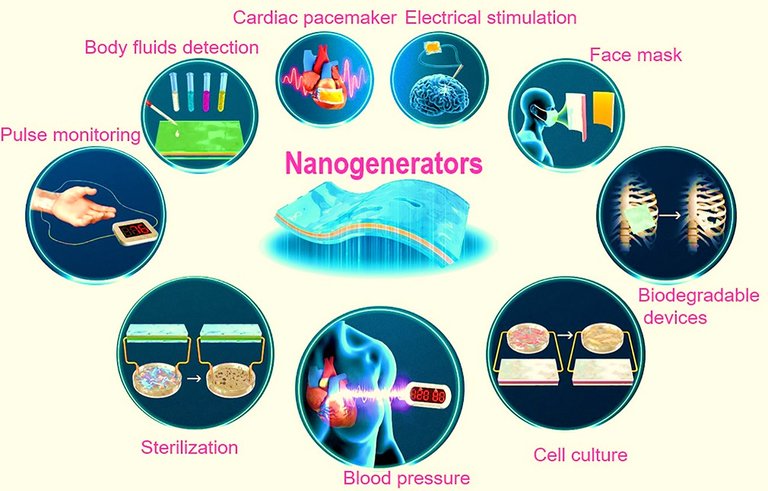As a researcher, I am always interested in how the technology that I am working with can make a great difference in the field of science and technology. In the case of Human Machine Interface (HMI), which is a developing sector that connects the general tech lover with its revolutionary inventions already. From virtual reality to augmented reality, gaming kits, and artificial intelligence in robots, everything is improving with the core mechanism of HMI. Being a relatively new technology, nanogenerators are not lagging behind in their application of them in improved Human machine interfaces. Working in the nanogenerators technology, I've come to believe that nanogenerators can offer a good solution to many limitations that the existing HMI technologies are suffering from, especially the problem with the portable Li-ion batteries and miniaturization that can be revolutionized with these nanogenerators. The new technology can lead to a future where smart gadgets will be smarter with small sizes and with self-powered mechanisms that can be in the form of comfortable when the questions comes to making these gadgets wearable.
The area of Human-machine interfaces (HMIs) is vast, and the range is expanding every day with the rapid growth of science and technology. It is used in many different things, from health trackers that you wear to robotic limbs to AR/VR systems that put us in virtual worlds in fancy gaming technologies or enjoying 3D movies. Although these technologies are new, they often have the same problem: they need a lot of portable batteries for the supply of energy to work. Batteries and other traditional power sources are bulky in size, and their residuals are bad for the earth, and disposal of them is not eco-friendly and can take very long. In this crucial point, nanogenerators are the one and only solution to change the complete scenario as they offer many self-charging opportunities to run smaller portable electronic sensors and devices. Consider what would happen if typing, walking, or even breathing could make enough energy to power these things. Here's where nanogenerators really come into play.
So, what is a nanogenerator? In simple words, nanogenerators are very small devices in many forms that convert mechanical energy into electricity based on many mechanisms and effects. I am not going to the dept in this section, but the introduction of some of them is in the following parts.
One of the most commonly known phenomena is the Piezoelectric Effect, which is the core mechanism for the Piezoelectric Nanogenerator (PENG). When a material undergoes physical deformation, I mean when you stretch or squeeze some materials, there will be changes in the electric charge in the material with the arrangement of the charge carriers in the materials. For example, Zinc oxide (ZnO) nanowires or PVDF polymers can turn mechanical energy into electrical energy when you hit it like a button at a certain frequency.
Another popular mechanism of nanogenerators is the Triboelectric Effect, which is the core mechanism of the Triboelectric Nanogenerator (TENG). It denotes the same way that static energy exists when two different objects with different potentials touch each other; the surface charges are transferred between them. Triboelectric nanogenerators (TENGs) can get energy from normal tasks like walking or typing by making the best use of materials and structures. It is really a fascinating way to produce some extra energy from those ignored sources that we barely realize like our breathing can be sensed with TENGs, which was my last project; hopefully, I will write about it when my article is published.
There are also some other effects, such as the Pyroelectric effect, Thermoelectric effect, Electrochemistry, wind-driven nanogenerators, and so many kinds of nanogenerators. These nanogenerators are developed using the scope of studying nanomaterials and their excellent properties. As I studied these technologies during my study, I was always amazed at how these effects could be used effectively to make self-powered HMI systems that are both more environmentally friendly and easier to use in many applications area.
The rapid development in new materials with enhanced properties, newer technologies for fabricating devices effectively and novel structures are making nanogenerators a great topic for deploying them in the HMI research area. Every day, new application areas are being investigated. Here, I am summarizing the well-established areas where nanogenerators are playing an excellent role in the development of Human-machine interface technology to reshape the technology.
I want to mention the Healthcare System as the number one priority and most interesting work in recent times. Nanogenerators can effectively supply power to many wearable devices that can check critical signs like blood pressure, heart rate, and body temperature in real-time without any battery requirement. Imagine having a patch on your skin that works with your moves to track your health 24 hours a day, 7 days a week, and providing you the updates through your mobile phone. It is like a dream for years for the scientific community.
Nanogenerators are also playing an important role in the field of mechanical and artificial limbs for the development of robotics. These devices are being improved by self-powered touch sensors that work perfectly, just like smart skin that is operated by a nanogenerator. Nanogenerators give robots an opportunity to feel a tough or smooth surface by touch, and they can also capable to give feedback to the users.
Nanogenerators have opened up a new door to the Internet of Things (IoT) and smart home applications as they offer the decentralization of the sensor technologies. Nanogenerators can effectively deliver power to IoT devices in smart homes, industries, or for the environmental sensors outdoors, so batteries don't have to be changed as often as we need now.
The AR/VR Systems are also getting much opportunity in making these devices lightweight with he help of nanogenerators. Nanogenerators can make the technology more effective with faster communication with body movement and augmented and virtual reality sensors. Self-powered gloves or suits, for instance, can give physical feedback within a short time with exact changes in real-time without any further need for other tools for analyzing data heavily, which makes virtual experiences more real.
With all the good things still nanogenerator is a new technology that is suffering from a couple of challenges. The number one challenge is the lower power output, which makes them face troubles when the power requirement is higher. That opens up newer technologies for the development of self-charging capacitors, but they still need long-term solutions by searching for new materials and designs for higher outputs. Another crucial problem is the durability of these devices is still at the primary level and needs to be developed for better application scenarios from the technology.
In conclusion, I want to say that it's been a great pleasure to work on nanogenerators as it is quite an interesting technology with a bright future. The devices that are being fabricated in the labs worldwide in this sector can give us the tools we need to make the future more sustainable and interactive, and there will be revolutionary changes in the HMI sectors with the nanogenerator technology.
For further reading, you can read some of the following articles:
Triboelectric Nanogenerator for Human-Machine Interfacing
Progress in the Triboelectric Human–Machine Interfaces (HMIs)-Moving from Smart Gloves to AI/Haptic Enabled HMI in the 5G/IoT Era
Triboelectric Nanogenerators: A New Energy Technology for Self-Powered Systems
Flexible Nanogenerators for Energy Harvesting and Self-Powered Electronics
Triboelectric bending sensor based smart glove towards intuitive multi-dimensional human-machine interfaces
A human-machine interactive hybridized biomechanical nanogenerator as a self-sustainable power source for multifunctional smart electronics applications
Self-Powered Smart Systems for Wearable Electronics Based on Triboelectric Nanogenerators
Triboelectric Nanogenerators for Internet of Things Applications
I hope you like blogging about my studies and work, and I hope you have learned something new from here. If you have any queries, please let me know in the comments, and I will try my best to answer them.
Thanks a lot for your time and attention. I will catch up with you at the next one.
Wish you a great day!



